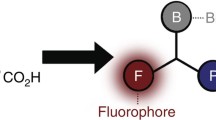Abstract
Novel bichromophoric fluorescent photolabile protecting group, (5-dansyloxy-3-hydroxynaphthalen-2-yl)methyl (DNS-NQMP), allows for the independent photochemical release and fluorescent imaging of caged substrates. Irradiation of DNS-NQMP-caged alcohols and carboxylic acids with 300 or 350 nm light results in fast (krelease ~ 105 s-1), efficient (Φ = 0.2), and quantitative release of the substrates. This uncaging chemistry is compatible with aqueous media and DNS-NQMP-protected hydroxy compounds are hydrolytically stable at neutral pH. Upon excitation with 400 nm light, caged compounds show intense green emission (λmax = 559 nm) with 21% fluorescence quantum yield. Fluorescent readout conducted using 400 nm or longer wavelengths does not cause substrate release. The DNS-NQMP chromophore retains its fluorescent properties after photo-uncaging reaction.
Similar content being viewed by others
References
T. W. Greene and P. G. M. Wuts, Protective groups in Organic Synthesis, Wiley, New York, 1991.
A. P. Pelliccioli and J. Wirz, Photoremovable protecting groups: reaction mechanisms and applications, Photochem. Photobiol. Sci., 2002, 1, 441
C. G. Bochet, Photolabile protecting groups and linkers, J. Chem. Soc., Perkin Trans. 1, 2002, 125.
Biological Applications of Photochemical Switches, ed. H. Morrison, Wiley, New York, 1993
Dynamic Studies in Biology, ed. M. Goeldner and R. Givens, Wiley, Weinheim, 2005
G. Mayer and A. Heckel, Biologically Active Molecules with a “Light Switch”, Angew. Chem., Int. Ed., 2006, 45, 4900–49021.
V. N. R. Pillai, Photoremovable Protecting Groups in Organic Synthesis, Synthesis, 1980, 1
V. N. R. Pillai, in Organic Photochemistry, A. Padwa, ed. Marcel Dekker, New York, 1987, Vol. 9, pp. 225–323.
S. P. A. Fodor, J. L. Read, M. C. Pirrung, L. Stryer, A. T. Lu and D. Solas, Light-directed, spatially addressable parallel chemical synthesis, Science, 1991, 251, 767
M. J. Heller, DNA MICROARRAY TECHNOLOGY: Devices, Systems, and Applications, Annu. Rev. Biomed. Eng., 2002, 4, 129
X. Gao, E. LeProust, H. Zhang, O. Srivannavit, E. Gulari, P. Yu, C. Nishiguchi, Q. Xiang and Z. Xiaochuan, A flexible light-directed DNA chip synthesis gated by deprotection using solution photogenerated acids, Nucleic Acids Res., 2001, 29, 4744
R. J. Lipshutz, S. P. A. Fodor, T. R. Gingeras and D. J. Lockhart, High density synthetic oligonucleotide arrays, Nat. Genet., 1999, 21, 20
M. C. Pirrung, L. Fallon and G. J. McGall, Proofing of Photolithographic DNA Synthesis with 3′,5′-Dimethoxybenzoinyloxycarbonyl-Protected Deoxynucleoside Phosphoramidites, J. Org. Chem., 1998, 63, 241
Y. Kobayashi, M. Sakai, A. Ueda, K. Maruyama, T. Saiki and K. Suzuki, Writing and Reading Methodology for Biochips with Sub-100-nm Chemical Patterns Based on Near-Field Scanning Optical Microscopy, Anal. Sci., 2008, 24, 571.
J. P. Colletier, A. Royant, A. Specht, B. Sanson, F. Nachon, P. Masson, G. Zaccai, J. L. Sussman, M. Goeldner, I. Silman, D. Bourgeois and M. Weik, Use of a “caged” analogue to study the traffic of choline within acetylcholinesterase by kinetic crystallography, Acta Crystallogr., Sect. D: Biol. Crystallogr., 2007, 63, 1115
D. Bourgeois and A. Royant, Advances in kinetic protein crystallography, Curr. Opin. Struct. Biol., 2005, 15, 538
V. Srajer, T.-Y. Teng, T. Ursby, C. Pradervand, Z. Ren, S.-I. Adachi, W. Schildkamp, D. Bourgeois, M. Wulff and K. Moffat, Photolysis of the carbon monoxide complex of myoglobin: nanosecond time-resolved crystallography, Science, 1996, 274, 1726
I. Schlichting, S. C. Almo, G. Rapp, K. Wilson, K. Petratos, A. Lentfer, A. Wittinghofer, W. Kabsch, E. F. Pai, G. A. Petsko and R. S. Goody, Time-resolved X-ray crystallographic study of the conformational change in Ha-Ras p21 protein on GTP hydrolysis, Nature, 1990, 345, 309.
C. Muller, P. Even, M.-L. Viriot, M.-C. Carre, Protection and Labelling of Thymidine by a Fluorescent Photolabile Group, Helv. Chim. Acta, 2001, 84, 3735–3741
K. Burgess, S. E. Jacutin, D. Lim and A. Shitangkoon, An Approach to Photolabile, Fluorescent Protecting Groups, J. Org. Chem., 1997, 62, 5165–5168
X. J. Tang and I. J. Dmochowski, Phototriggering of Caged Fluorescent Oligodeoxynucleotides, Org. Lett., 2005, 7, 279.
M. J. G. Fernandes, M. S. Goncalves, S. P. G. Costa, Comparative study of polyaromatic and polyheteroaromatic fluorescent photocleavable protecting groups, Tetrahedron, 2008, 64, 3032–3038
A. Jana, S. Atta, S. K. Sarkar, N. D. P. Singh, 1-Acetylpyrene with dual functions as an environment-sensitive fluorophore and fluorescent photoremovable protecting group, Tetrahedron, 2010, 66, 9798–9807
M. Iwamura, C. Hodota and M. Ishibashi, 1-(a-Diazobenzyl)pyrene: A Reagent for Photolabile and Fluorescent Protection of Carboxyl Groups of Amino Acids and Peptides, Synlett, 1991, 35–36
A. K. Sing and P. K. Khade, Anthracene-9-methanol-a novel fluorescent phototrigger for biomolecular caging, Tetrahedron Lett., 2005, 46, 5563–5566
A. M. Piloto, A. M. S. Soares, G. Hungerford, S. P. G. Costa and M. S. Goncalves, Long-Wavelength Photolysis of Amino Acid 6-(Methoxy-2-oxo-2H-naphtho[1,2-b]pyran-4-yl)methyl Esters, Eur. J. Org. Chem., 2011, 5447–51.
B. Schade, V. Hagen, R. Schmidt, R. Herbrich, E. Krause, T. Eckardt and J. Bendig, Deactivation Behavior and Excited-State Properties of (Coumarin-4-yl)methyl Derivatives. 1. Photocleavage of (7-Methoxycoumarin-4-yl)methyl-Caged Acids with Fluorescence Enhancement, J. Org. Chem., 1999, 64, 9109–9117
V. Hagen, B. Dekowski, V. Nache, R. Schmidt, D. Geissler, D. Lorenz, J. Eichhorst, S. Keller, H. Kaneko, K. Benndorf and B. Wiesner, Coumarinylmethyl Esters for Ultrafast Release of High Concentrations of Cyclic Nucleotides upon One- and Two-Photon Photolysis, Angew. Chem., Int. Ed., 2005, 44, 7887–91.
A. Kulikov, S. Arumugam and V. V. Popik, Photolabile Protection of Alcohols, Phenols, and Carboxylic Acids with 3-Hydroxy-2-Naphthalenemethanol, J. Org. Chem., 2008, 73, 7611–7615.
S. Arumugam and V. V. Popik, Light-Induced Hetero-Diels–Alder Cycloaddition: A Facile and Selective Photoclick Reaction, J. Am. Chem. Soc., 2011, 133, 5573–5579.
See the ESI†.
S. L. Murov, I. Carmichael and G. L. Hug, in Handbook of Photochemistry, Marcel Dekker, New York, 1993, p. 299.
S. Arumugam and V. V. Popik, Photochemical Generation and the Reactivity of o-Naphthoquinone Methides in Aqueous Solutions, J. Am. Chem. Soc., 2009, 131, 11892–11899.
Author information
Authors and Affiliations
Corresponding author
Rights and permissions
About this article
Cite this article
Arumugam, S., Popik, V.V. Bichromophoric fluorescent photolabile protecting group for alcohols and carboxylic acids. Photochem Photobiol Sci 11, 518–521 (2012). https://doi.org/10.1039/c1pp05317e
Received:
Accepted:
Published:
Issue Date:
DOI: https://doi.org/10.1039/c1pp05317e




